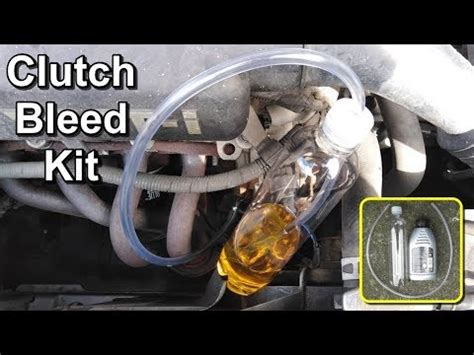Clutch Repair Made Simple: A Bleeding Tutorial
A slipping or spongy clutch pedal can signal the need for clutch bleeding—a crucial maintenance task often overlooked by even experienced car enthusiasts. This comprehensive guide simplifies the clutch bleeding process, empowering you to tackle this repair yourself and save on costly professional labor. We'll cover everything from understanding why bleeding is necessary to troubleshooting common issues, ensuring you get back on the road smoothly.
Why is Clutch Bleeding Necessary?
Your clutch system relies on hydraulic pressure to disengage the engine from the transmission. This pressure is generated by the master cylinder, travels through hydraulic lines, and actuates the slave cylinder, which in turn moves the clutch fork. Air bubbles in this hydraulic system impede the smooth flow of fluid, resulting in a spongy or unresponsive clutch pedal. Bleeding the system removes these air bubbles, restoring proper hydraulic pressure and clutch operation.
Tools You'll Need
Before you begin, gather these essential tools:
- A bleeding kit: This typically includes a clear hose, a container to collect fluid, and possibly a one-way valve.
- Brake fluid: Use the type specified in your vehicle's owner's manual. DOT 3 or DOT 4 are common. Never use anything else.
- Wrench(es): Appropriate sizes to access the bleeder valve on the slave cylinder.
- Jack and jack stands: Securely raise the vehicle and support it properly for safety.
- Gloves: Brake fluid is corrosive.
- Rags or shop towels: To clean up any spills.
- Owner's Manual: Consult it for specific instructions and torque specifications for your vehicle.
How to Bleed Your Clutch: A Step-by-Step Guide
This is a general guide. Always consult your vehicle's owner's manual for specific instructions and locations of components.
-
Preparation: Park your vehicle on a level surface, engage the parking brake firmly, and ensure the engine is off.
-
Locate the Bleeder Valve: This valve is usually located on the slave cylinder, typically found near the transmission bell housing. It's a small valve with a small opening.
-
Attach the Bleeding Kit: Attach one end of the clear hose to the bleeder valve and submerge the other end in a container filled with brake fluid. This allows you to visually see the fluid and any air bubbles escaping.
-
Prepare Your Assistant: You'll need an assistant to pump the clutch pedal while you monitor the fluid.
-
The Bleeding Process: Have your assistant slowly and firmly pump the clutch pedal several times. While they hold the pedal down, carefully open the bleeder valve with your wrench, allowing fluid and air to escape into the hose. Close the valve before your assistant releases the pedal. Repeat this process multiple times until you see a steady stream of fluid without any air bubbles.
-
Refill the Master Cylinder: During the bleeding process, monitor the fluid level in the master cylinder reservoir and refill as needed to prevent air from being sucked back into the system.
-
Test the Clutch: Once the bleeding is complete, have your assistant pump the clutch pedal several times. It should feel firm and responsive. Carefully lower your vehicle and test drive it to confirm proper clutch engagement and disengagement.
Troubleshooting Common Issues
-
Clutch Pedal Still Spongy: If the pedal remains spongy after bleeding, there may be a leak in the system. Check all hoses and connections for damage or leaks. A faulty master or slave cylinder may also be the culprit.
-
No Fluid Flow: Verify that the bleeder valve is properly opened and that the hose is securely attached. If the issue persists, the bleeder valve might be clogged.
-
Low Fluid Level: Constantly low fluid levels may indicate a leak in the system. Address any leaks before bleeding again.
Frequently Asked Questions (PAAs)
How often should I bleed my clutch?
The frequency of clutch bleeding depends on your vehicle's age, usage, and driving conditions. There isn't a strict schedule; however, if you notice a spongy or unresponsive clutch pedal, it's time to bleed the system.
Can I bleed the clutch myself?
Yes, with the right tools and a little patience, you can bleed your clutch yourself. This guide provides a step-by-step process. However, if you're uncomfortable working on your vehicle, consult a professional mechanic.
What type of brake fluid should I use?
Always use the type of brake fluid specified in your vehicle's owner's manual. Using the wrong type can damage your clutch system.
What happens if I don't bleed my clutch?
If you don't bleed your clutch, the air bubbles in the system will hinder the hydraulic pressure, causing a spongy or unresponsive clutch pedal. This can lead to difficulty shifting gears and eventually clutch failure.
By following this guide and taking necessary precautions, you can successfully bleed your clutch, restoring its performance and saving yourself the expense of professional repair. Remember safety first, and if you're unsure about any step, consult a qualified mechanic.

